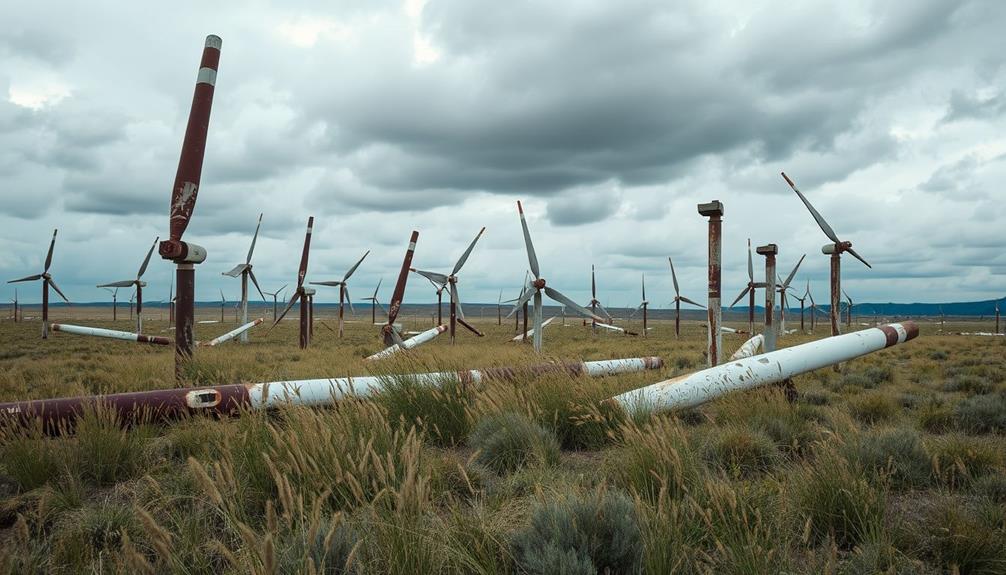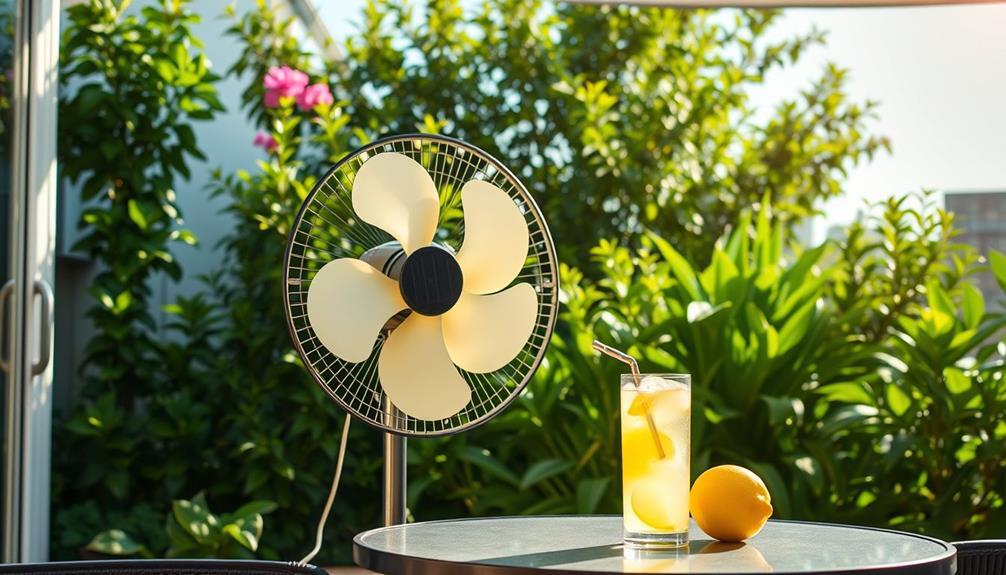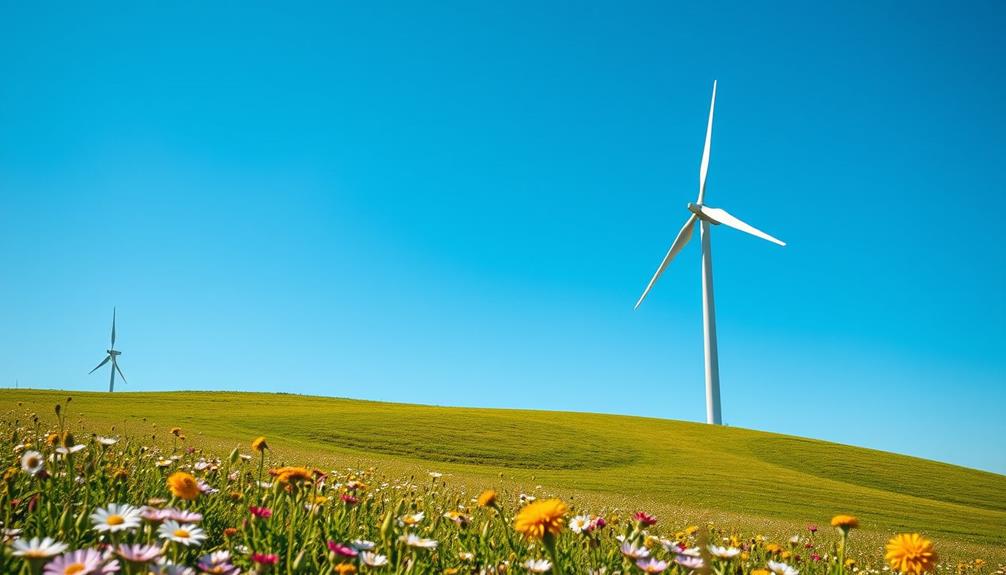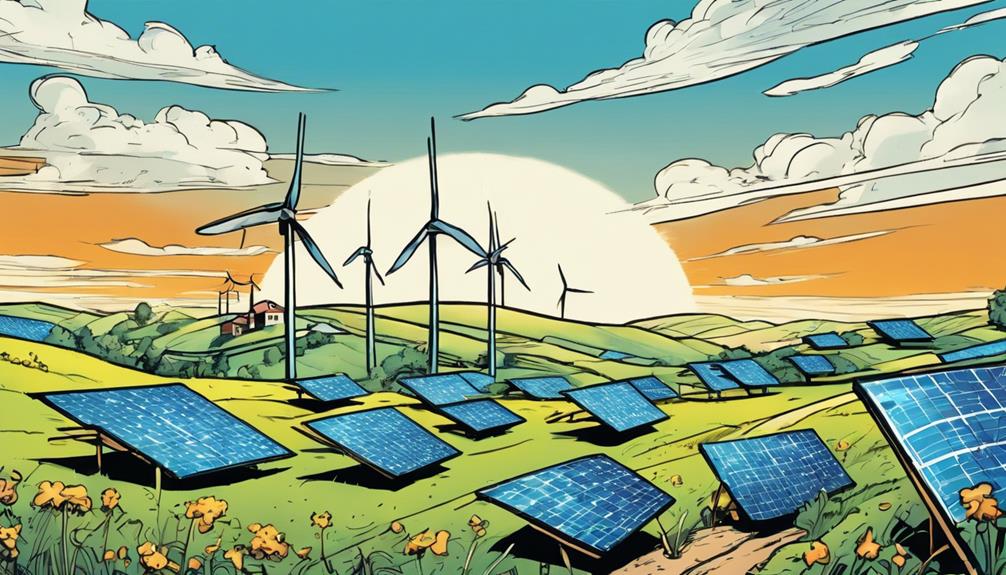Wind turbine graveyards expose a harsh truth about wind energy waste. Each turbine blade can consume up to 7 cubic yards of landfill space, and with projections of around 2.1 million tons of blade waste by 2050, the environmental impact is significant. While about 85% of turbine components can be recycled, the tough materials used in blades complicate disposal. Many local landfills refuse to accept these durable structures, leading to a pressing waste management issue. Major companies are exploring more sustainable disposal methods, but challenges remain. Keep exploring to uncover how innovators are tackling this pressing issue.
Key Takeaways
- Wind turbine graveyards highlight the significant challenge of disposing robust fiberglass blades, complicating waste management efforts.
- Approximately 2.1 million tons of wind turbine waste are projected by 2050, raising environmental concerns.
- Each wind turbine blade consumes about 7 cubic yards of landfill space, contributing to landfill limitations.
- Innovative recycling solutions are still under development, with only a few facilities capable of processing fiberglass blades effectively.
- Major companies are under pressure to find sustainable disposal methods, aiming for zero waste by 2040.
Wind Turbine Blade Disposal Challenges
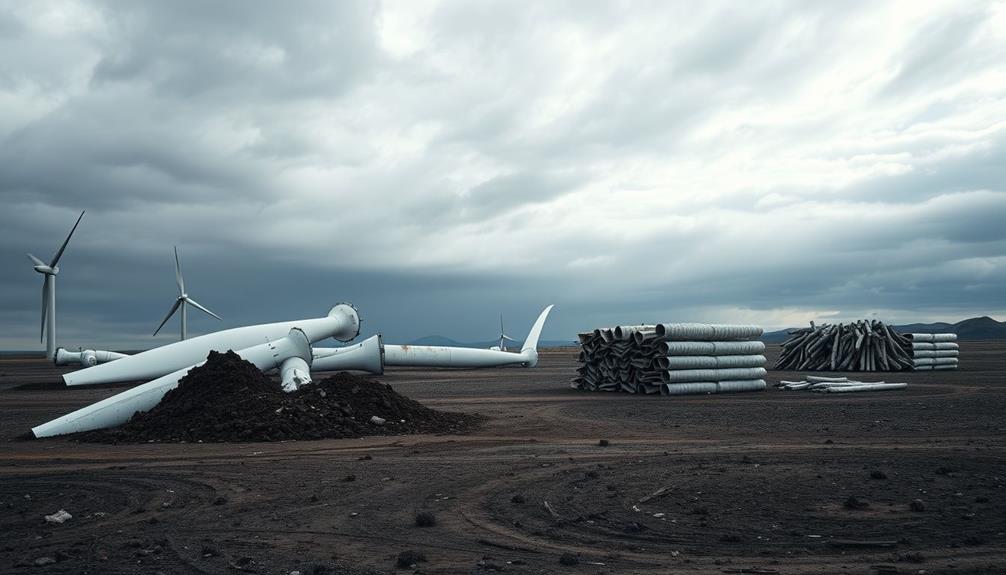
The disposal of wind turbine blades presents significant challenges that the industry must address. Most blades are designed to endure extreme stress, which makes them incredibly tough to break down. As a result, when these blades reach the end of their life, they often end up in landfills, consuming about 7 cubic yards of space each.
This raises concerns about the sheer volume of waste generated, with projections indicating that around 2.1 million tons of wind turbine blade waste could accumulate by 2050. Additionally, just like heat pumps, which also face disposal challenges at the end of their operational life, the wind energy sector must prioritize innovative recycling methods to mitigate waste.
In Wyoming, facilities like the Logan County Landfill have started accepting worn-out blades, with Casper Landfill reportedly processing around 784 blades. However, many smaller landfills refuse to take them due to their robust structure, limiting your recycling options.
This reliance on landfills not only complicates disposal efforts but also highlights the urgent need for better recycling methods and sustainable practices. Without addressing these challenges, the industry risks creating a significant waste problem that could overshadow the environmental benefits of wind energy.
You can see how critical it's to find innovative solutions for wind turbine blade disposal.
Environmental Impact of Turbine Waste
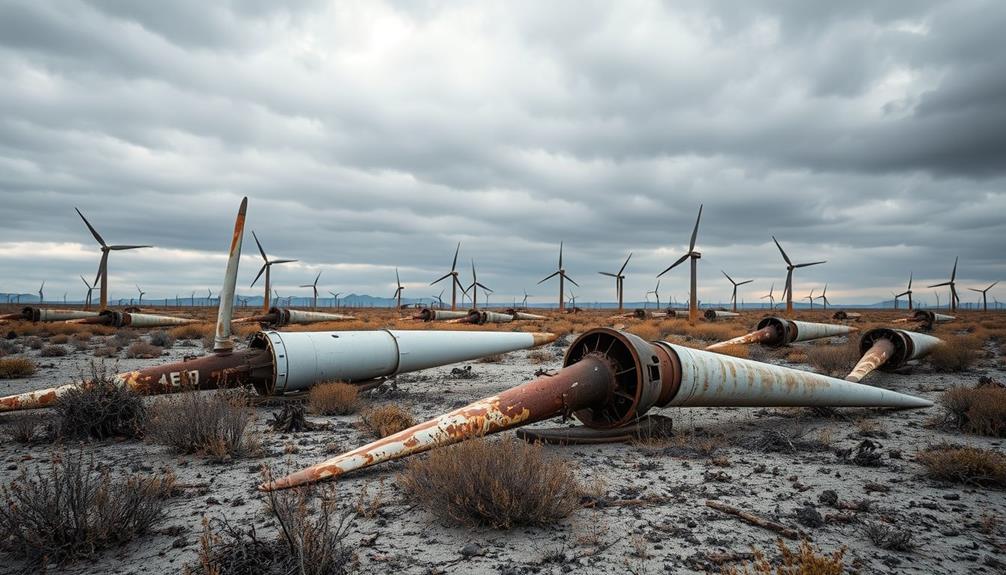
Wind turbine waste poses a significant environmental challenge that can't be ignored. By 2050, we could see around 2.1 million tons of used wind turbine blades piling up, raising serious concerns about the sustainability of renewable energy.
While about 85% of turbine components are recyclable, the blades themselves are made from materials that are notoriously difficult to recycle. This creates significant disposal challenges, as each blade occupies about 7 cubic yards of landfill space, leading to environmental strain.
As the average turbine produces 1.5 to 3 MW of power, the scale of energy production must be balanced against the waste generated, highlighting the need for sustainable practices in the industry advanced materials increase strength.
The visible presence of wind turbine graveyards, where these blades are stored or disposed of, impacts public perception of wind energy's sustainability. As these graveyards grow, so does scrutiny over the industry's circular economy practices.
Major companies, like Vestas, are feeling the pressure to innovate greener disposal methods, aiming for a zero-waste goal by 2040.
If the wind energy sector wants to maintain its reputation as a clean alternative, tackling the environmental impact of turbine waste is essential. Without effective solutions, the promise of renewable energy may be overshadowed by the growing burden of turbine waste. One aspect of turbine waste that needs to be addressed is the disposal of wind turbine blades. These blades are typically made of composite materials that are difficult to recycle or repurpose, leading to a significant environmental impact. Additionally, the lifespan of these blades is a concern, as they can last up to 20 years before needing to be replaced. This raises the question: how long are wind turbine blades and what implications does this have for their disposal and environmental impact? Finding sustainable solutions for turbine waste, including the blades, will be crucial for the long-term success of the wind energy sector.
Technological Innovations in Recycling
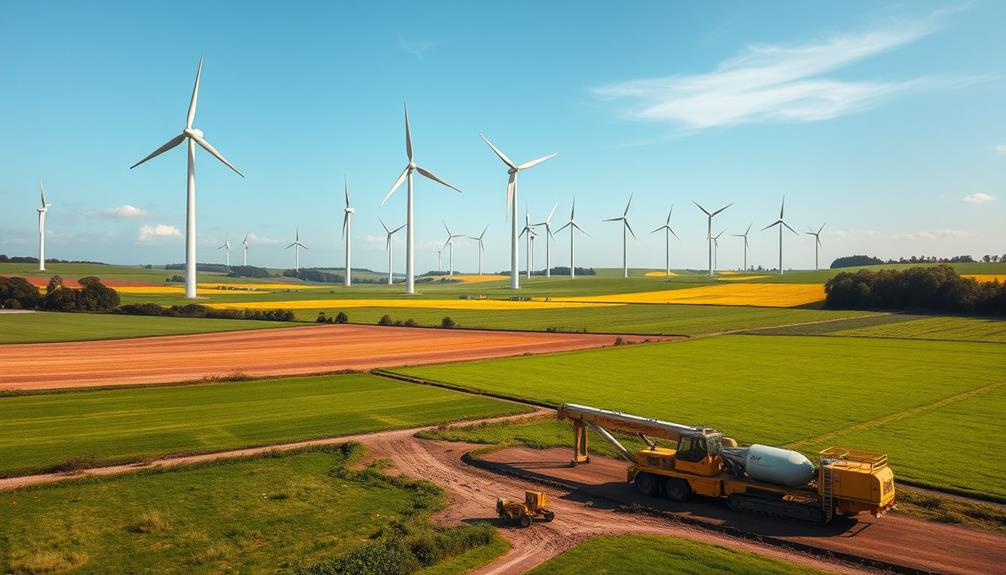
Innovations in recycling are paving the way for a more sustainable future in wind energy. By focusing on the recyclability of old turbine blades, companies and researchers are embracing the circular economy, turning waste into valuable resources.
| Location | Innovation |
|---|---|
| Denmark | First recyclable wind turbine blades |
| CETEC Coalition | Enhancing recyclability of blades |
| Norway | Extracting fiberglass for reuse |
| Munster, Ireland | Pedestrian bridge from old blades |
| Georgia Tech | Repurposing blades as roofing |
For instance, Denmark has led the charge with the creation of commercially viable recyclable blades, while the CETEC coalition is driving innovation in material recovery processes. In Norway, Akers Offshore Wind has developed techniques to extract fiberglass from used blades, showcasing a practical reuse approach. Meanwhile, researchers at Munster Technological University have creatively constructed a pedestrian bridge from repurposed blades. At the Georgia Institute of Technology, innovative ideas continue to emerge, with plans to turn decommissioned blade sections into roofing materials. Each of these advancements helps to minimize waste and supports a sustainable future in wind energy.
Legislative Actions and Industry Movements
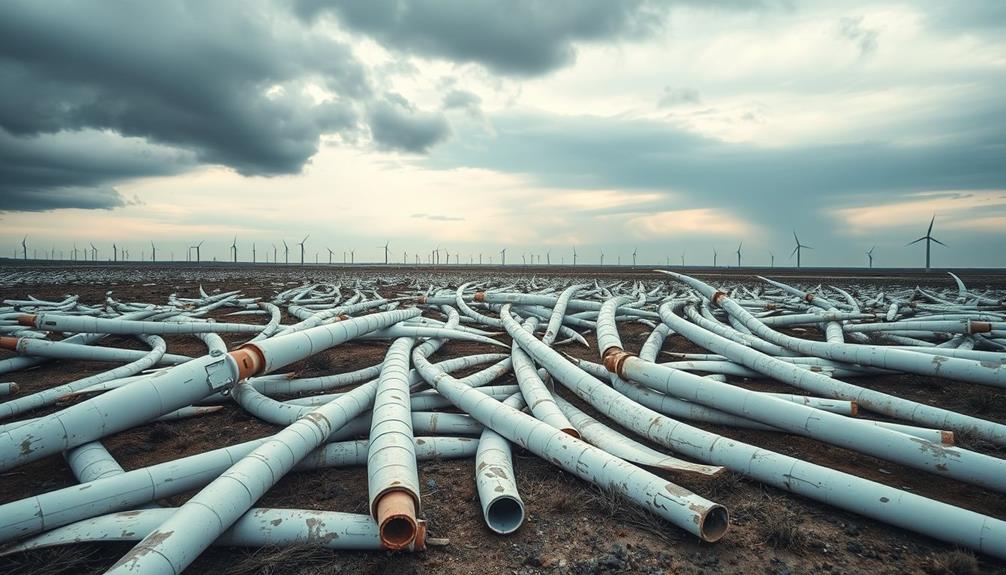
Efforts are underway to tackle the growing challenge of wind turbine blade disposal, as legislators and industry leaders recognize the pressing need for sustainable solutions. In Wyoming, lawmakers have proposed a bill to ban landfill acceptance of wind turbine blades, signaling a strong push for alternative disposal methods. This legislative action reflects the urgency surrounding the projected 2.1 million tons of wind turbine blade waste expected by 2050.
Understanding the potential economic impact of this waste management issue is essential, as it can affect investment opportunities in the renewable energy sector, particularly when considering investment regulations.
The wind energy industry is feeling the pressure to innovate. Ongoing discussions reveal a commitment to developing improved recycling technologies and practices for managing used turbine blades. Instead of sending blades to landfills, some companies are opting to store them while they explore better recycling options. This shift indicates a growing awareness of the environmental impact and a desire to find effective solutions.
Additionally, economic development talks in Colorado aim to establish new processing facilities specifically designed for wind turbine blade disposal. These movements show that both legislators and industry leaders are taking significant steps towards creating a more sustainable future, ensuring that the wind energy sector can address its waste challenges proactively.
Future Outlook for Sustainable Practices
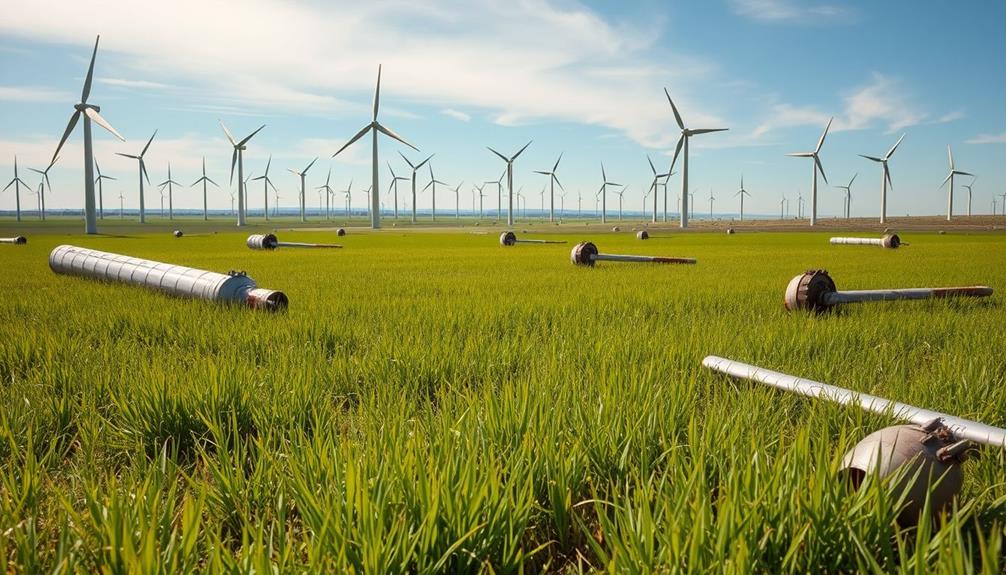
As the wind energy sector grapples with significant waste management challenges, holistic SEO approaches can provide valuable insights into creating sustainable practices.
A clear path toward sustainable practices is becoming increasingly essential. With projections estimating 2.1 million tons of wind turbine blade waste by 2050, the urgency for innovative disposal and recycling methods can't be overstated. Companies like Vestas are setting ambitious goals, aiming for zero waste by 2040, which drives them to explore green disposal strategies for wind turbine blades.
Research into thermoplastic resins is promising, as these materials can be recovered under high heat, making recycling fiberglass more feasible.
Initiatives such as the CETEC coalition in Denmark demonstrate the industry's commitment to enhancing recyclability, showcasing how collaboration can lead to real progress.
Long-term sustainability goals emphasize developing viable recycling processes to minimize landfill dependency and promote circular economy principles.
By focusing on these sustainable energy practices, you can help guarantee that wind energy remains a viable option for the future while addressing waste concerns.
The combined efforts of industry leaders and researchers will pave the way for a greener, more sustainable future in wind energy, ultimately benefiting both the environment and society.
Understanding Wind Energy Growth
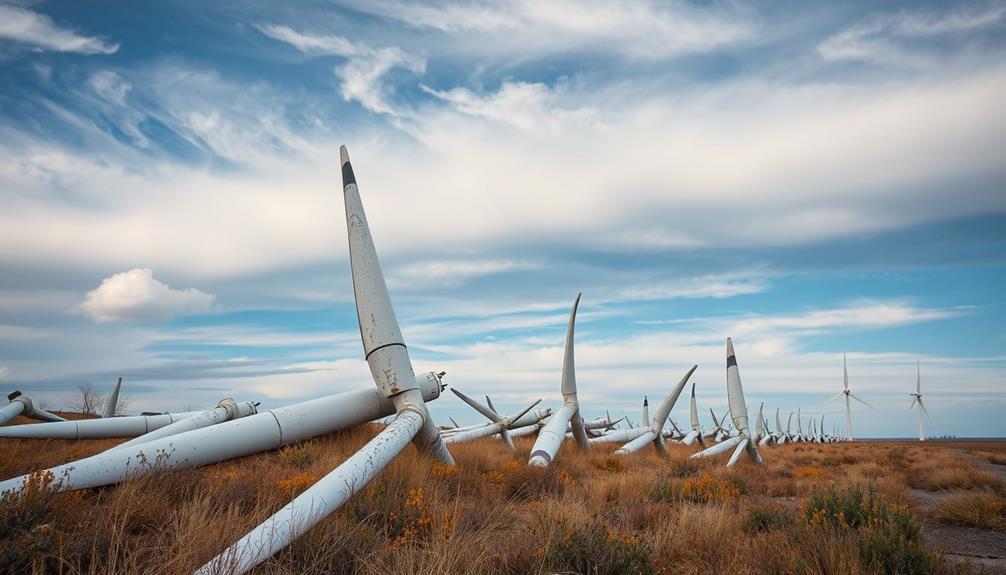
The remarkable growth of wind energy has transformed the global energy landscape, making it one of the fastest-growing renewable sources. In November 2023, wind power even accounted for an astonishing 69% of the UK's electricity generation, showcasing just how significant this energy source has become.
With a nearly 50% rise in renewable energy capacity this year, it's clear that wind turbines are taking center stage in electricity production. This shift towards renewables is vital as it aligns with the need for AI ethicist jobs that focus on the ethical implications of new technologies in energy.
By 2026, projections indicate that renewables will surpass hydropower, coal, and nuclear energy, reflecting a significant shift towards sustainable energy solutions. Currently, renewables represent almost one-third of global electricity generation, underlining their expanding role in meeting energy demands.
This momentum for wind energy growth is largely fueled by technological advancements and increased investments, signaling a bright future for wind power.
As you consider the future of energy, it's important to recognize the potential of wind turbines not just for today, but for generations to come. The increasing reliance on wind energy highlights our commitment to a cleaner, more sustainable planet, making it necessary to understand its growth and impact on our world.
Wind Turbine Graveyards Explained
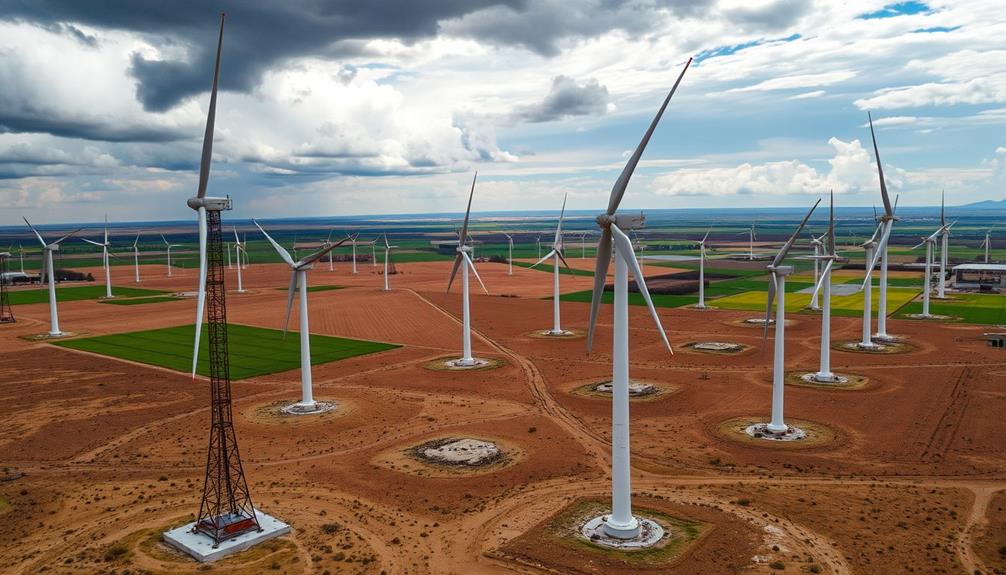
You mightn't realize that wind turbine graveyards highlight significant disposal challenges, especially with the blades that are tough to recycle.
These challenges are compounded by the need for cold medications overview to address potential health issues for workers involved in the disposal process.
Fortunately, innovative recycling methods are emerging, aiming to address these issues and promote sustainability.
Understanding the lifecycle assessment of these turbines is essential for improving waste management practices in the renewable energy sector.
Disposal Challenges Faced
Disposing of wind turbine blades poses significant challenges due to their size and material composition. The primary blade material is fiberglass, which, while strong, complicates disposal. Local landfills often have the discretion to accept these blades, leading to inconsistent disposal practices. Each blade can take up about 7 cubic yards of space, making it a substantial contributor to waste management issues.
| Disposal Method | Challenges |
|---|---|
| Landfilling | Limited space; local acceptance varies |
| Incineration | Emissions from burning composite materials |
| Recycling | Few facilities capable of processing fiberglass |
| Repurposing | Limited creative options for large structures |
| Innovative solutions | Still in development; not widely implemented |
Despite the fact that roughly 85% of wind turbine components are recyclable, the fiberglass blades present considerable disposal challenges. With projections indicating that over 6,500 blades will need removal annually in Europe by 2025, the environmental impact of this waste is concerning. Companies like GE and Vestas are actively working on greener disposal methods, with Vestas setting a zero-waste goal by 2040.
Recycling Innovations Emerging
As the wind energy sector grapples with the disposal challenges of fiberglass blades, innovative recycling solutions are emerging to address these issues. Companies like Global Fiberglass Solutions are leading the charge by recycling wind turbine blades into new products such as polymer concrete and guardrails. This not only mitigates waste but also creates valuable materials for construction.
Additionally, the integration of unique and wicked planters in urban spaces can complement these sustainable initiatives, promoting greener environments. Researchers at the National Renewable Energy Laboratory (NREL) are exploring thermoplastic resins that can be recovered under high heat, offering a significant advancement in recycling innovations.
Denmark is at the forefront, having produced the first commercially recyclable wind turbine blades, which showcases effective end-of-life options for turbine components. Moreover, the CETEC coalition in Denmark is dedicated to enhancing the recyclability of turbine blades, emphasizing collaborative efforts within the industry for sustainable solutions.
Institutions like Munster Technological University in Ireland are also making strides by repurposing wind turbine blade materials into pedestrian bridges, highlighting creative recycling applications that extend the lifecycle of these materials.
Together, these efforts signal a promising shift toward a more sustainable future for wind energy and its associated waste.
Lifecycle Assessment Importance
Lifecycle assessments (LCAs) frequently play a vital role in understanding the environmental impact of wind turbine blades. By examining the entire lifecycle—from material extraction to disposal—LCAs highlight areas where sustainability can be improved.
As with coffee brewing methods, where different approaches can affect the end result, the materials used in wind turbines also influence their environmental footprint. While about 85% of wind turbine materials are recyclable, the blades themselves present major challenges due to their tough structure and the use of hard-to-recycle thermoset plastics.
With projections estimating that wind turbine blade waste could reach 2.1 million tons by 2050, it's clear that effective recycling and disposal solutions are essential. Incorporating LCAs into the wind energy planning process allows you to make informed decisions about materials and technologies that minimize waste.
This approach also fosters innovation, as research into sustainable disposal methods becomes vital, like converting blades into new products.
Challenges of Blade Recycling
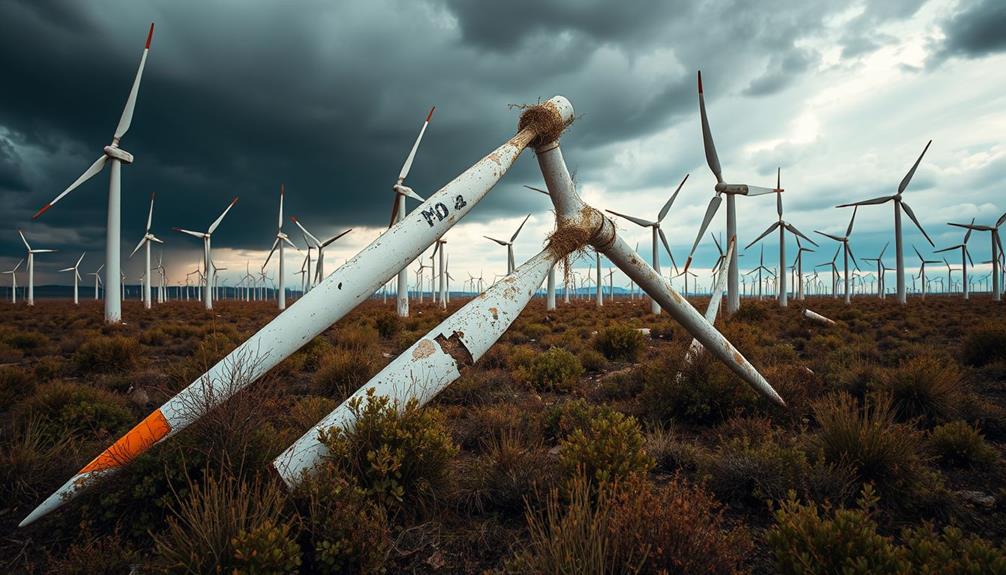
Wind turbine blades represent one of the most significant challenges in renewable energy waste management. While about 85% of wind turbine components can be recycled, the blades are made from thermoset plastics that are notoriously difficult to process. This creates a pressing issue as global wind turbine blade waste is projected to hit 2.1 million tons by 2050.
In comparison to other materials, the durability of these blades makes them less adaptable to recycling efforts, similar to the challenges faced with best airless paint sprayers when handling specific paint types.
Here are some key challenges of blade recycling:
- Thermoset resins can't revert to a liquid state after curing, complicating recycling processes.
- The robust structure of blades is designed to withstand extreme conditions, making disposal tricky.
- Traditional recycling methods often fall short when it comes to these tough materials.
- Innovative solutions are still in development and not widely implemented.
- The urgency for effective recycling solutions is growing as more turbines reach end-of-life.
Innovative recycling methods are being explored, like Denmark's first recyclable blades for commercial use and initiatives by Global Fiberglass Solutions.
However, until efficient recycling technologies are widely adopted, the future of wind turbine blades remains a critical concern in managing renewable energy waste.
Materials Used in Turbine Blades
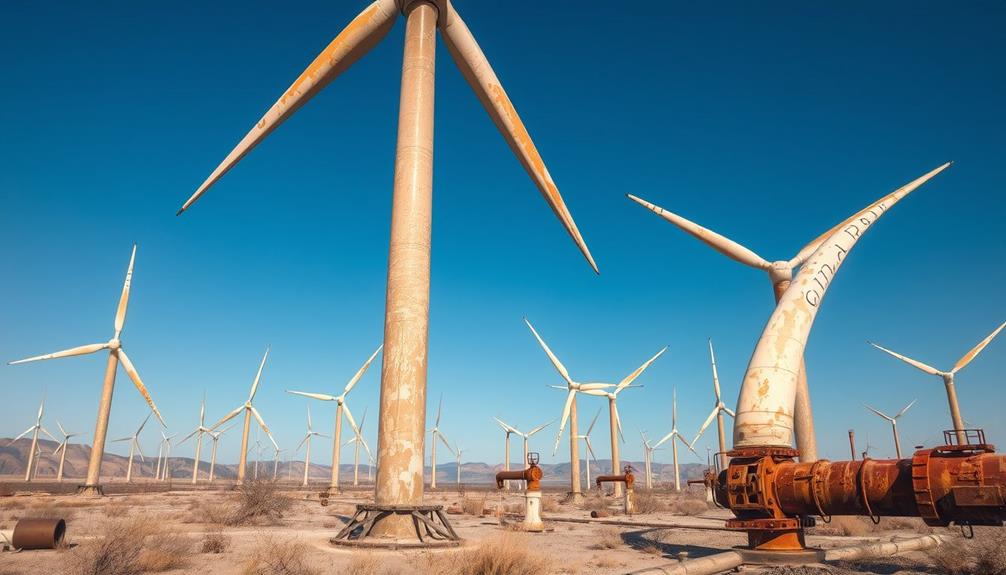
The materials used in turbine blades play a significant role in their performance and the challenges they present at the end of their lifecycle. Most blades are made from fiberglass, a composite material combining glass fibers and resin. This combination gives blades the strength they need, but it also complicates recycling efforts.
| Material Type | Properties | Recycling Challenges |
|---|---|---|
| Fiberglass | Strong, lightweight | Difficult to recycle |
| Thermoset Resins | Durable, heat-resistant | Cannot be melted or reused |
| Thermoplastic Resins | Potentially recyclable | Still under research |
As you consider old wind turbine blades, it's vital to recognize that about 85% of turbine components are recyclable. However, the blades themselves pose significant challenges due to their durable structure. Innovations, like recyclable blades developed in Denmark, aim to improve sustainability. With an estimated 2.1 million tons of blade waste projected by 2050, addressing these material issues is essential for a greener future in wind energy.
Cooling Methods for Turbine Efficiency
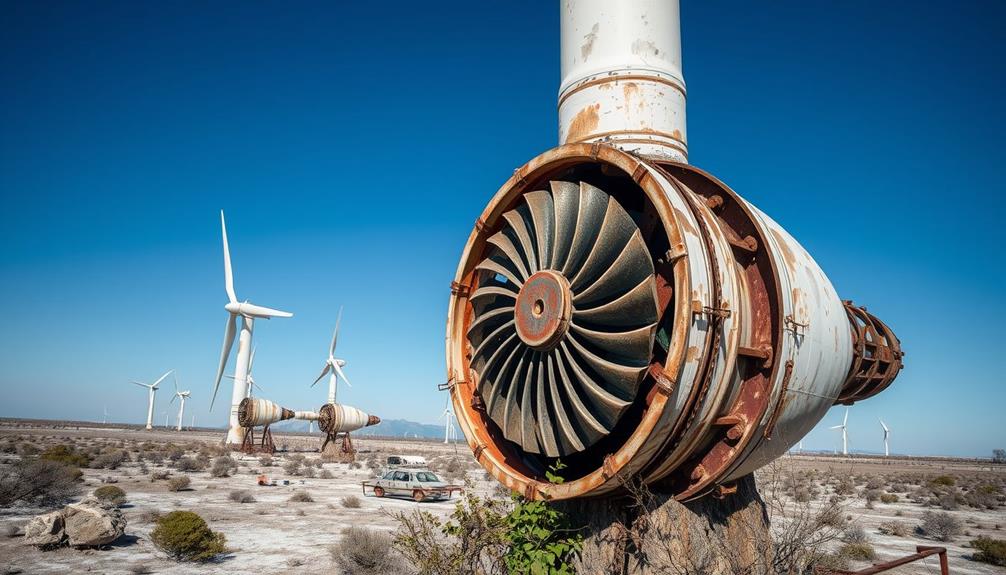
When you think about turbine efficiency, cooling methods play a vital role.
In today's rapidly changing energy landscape, a focus on design thinking principles can inspire innovative cooling solutions that enhance turbine performance.
You'll find that techniques like air cooling and advanced film cooling are essential for managing extreme temperatures and extending blade lifespan.
Innovations in these cooling strategies continue to emerge, driving improvements in turbine performance and energy efficiency.
Cooling Techniques Overview
Utilizing advanced cooling techniques is fundamental for enhancing turbine efficiency and performance. These methods guarantee that turbines can effectively convert wind energy into kinetic energy without succumbing to extreme temperatures that can lead to damage.
Here are some key cooling methods employed in turbine systems:
- Convection cooling: Uses airflow to dissipate heat from turbine blades.
- Film cooling: Creates a protective layer of cooler air along the blade surface.
- Transpiration cooling: Allows coolant to permeate through the blade surface, improving heat distribution.
- Effusion cooling: Similar to transpiration but focuses on more controlled coolant flow.
- Pin fin cooling: Incorporates small pins that enhance convective heat transfer.
With high turbine entry temperatures reaching up to 2,900°F (1,590°C), effective cooling strategies like internal cooling-air cavity purge flow are essential.
This approach prevents hot gas leakage onto turbine discs, safeguarding the integrity of the blades. Ongoing research aims to optimize these cooling techniques, extending the lifespan and performance of turbine blades, which is critical for maintaining efficiency in both gas and steam turbines.
Innovations in Cooling Methods
Innovations in cooling methods have transformed how turbine blades manage extreme temperatures, enhancing both efficiency and longevity. Turbine blades are made to withstand extreme conditions, with high turbine entry temperatures (TET) reaching up to 2,900°F (1,590°C) in advanced applications.
To combat the risk of damage, various cooling techniques, including air cooling, convection, and film cooling, have been developed.
Air cooling serves as the primary method, utilizing both internal and external strategies to prevent hot gas from leaking onto turbine discs. One of the most exciting advancements is the implementation of film cooling combined with dielectric barrier discharge plasma actuators. This technique considerably boosts cooling effectiveness, allowing blades to operate efficiently even under high thermal stress.
Researchers continually focus on improving these technologies, aiming to optimize turbine efficiency and extend the working life of blades. By addressing the challenges posed by high thermal and mechanical stresses, these innovations not only protect the structural integrity of turbine blades but also contribute to a more sustainable energy future.
With these advancements, wind energy can become a more reliable and efficient power source, reducing waste and enhancing overall performance.
Frequently Asked Questions
What Are Three Negative Effects of Wind Turbines?
You might notice three negative effects of wind turbines: they can harm wildlife, create noise pollution, and contribute to visual pollution. These issues can lead to community discontent and raise concerns about their environmental impact.
What Is the Main Problem Caused by Wind Turbines?
Imagine a giant tree, strong yet burdened with heavy branches. Wind turbines, like this tree, face a significant issue: their blades, tough to recycle, often end up in landfills, creating serious environmental concerns that can't be ignored.
What Is the Downfall of Wind Turbines?
The downfall of wind turbines lies in their environmental impact, particularly concerning blade disposal. You'll find that while most components are recyclable, the blades pose significant challenges, leading to growing waste management concerns in the industry.
Are Wind Turbine Blades Bad for the Environment?
Wind turbine blades can seem like environmental villains, given their disposal challenges. While most turbine components are recyclable, blades often end up in landfills, raising concerns about sustainability and the industry's long-term impact on the planet.
Conclusion
In the quest for renewable energy, you might not realize the hidden costs of wind turbine waste. While wind energy promises a cleaner future, the challenges of blade disposal and recycling reveal a paradox. It's essential to push for innovative solutions and legislative support that address these issues. By understanding the full lifecycle of wind turbines, you can advocate for sustainable practices that truly benefit the environment. Embracing this complexity helps guarantee a greener tomorrow for everyone.
